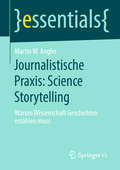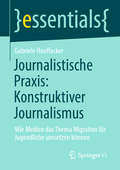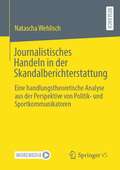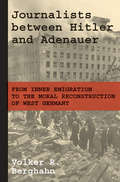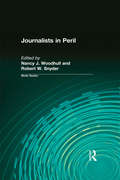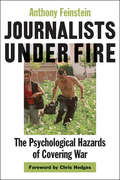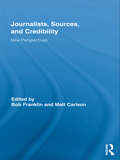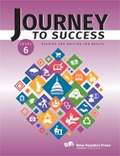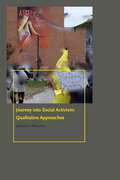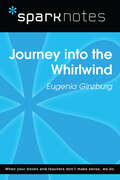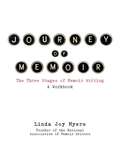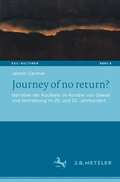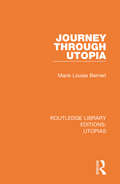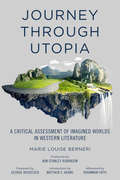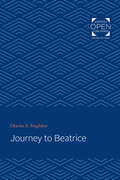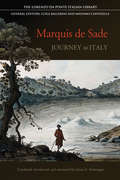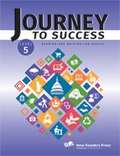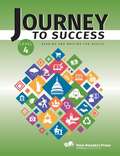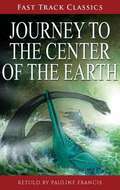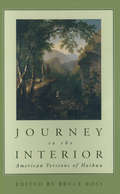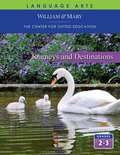- Table View
- List View
Journalistische Praxis: Warum Wissenschaft Geschichten erzählen muss (essentials)
by Martin W. AnglerWissenschaft muss gute Geschichten erzählen, um Fake News zu bekämpfen und um komplexe Themen zu vermitteln. Dazu gibt es erprobte Techniken, Strukturen, wiederkehrende Muster und Elemente, die in keiner guten Geschichte fehlen dürfen. Dieses essential zeigt, wieso wir so verdrahtet sind, auf Geschichten zu reagieren, wie sie auf unser Gehirn wirken und welche Techniken wir einsetzen können, um sie an jede Art von Publikum zu vermitteln, vom Geldgeber bis zum Kleinkind.
Journalistische Praxis: Wie Medien das Thema Migration für Jugendliche umsetzen können (essentials)
by Gabriele HooffackerHeranwachsende wünschen sich Medien, die verständlich berichten, Hintergründe und Lösungsmöglichkeiten aufzeigen. Wie das Konzept des konstruktiven Journalismus dabei hilft und wie es in der Journalismusausbildung eingesetzt werden kann, zeigt dieses Buch.
Journalistisches Handeln in der Skandalberichterstattung: Eine handlungstheoretische Analyse aus der Perspektive von Politik- und Sportkommunikatoren
by Natascha WehlischSkandale sind zweifellos ein wichtiges Korrektiv innerhalb demokratischer Gesellschaften. Gleichzeitig kritisieren Sozialwissenschaftler den verstärkten Einsatz von Skandalisierungen als Mittel im massenmedialen Aufmerksamkeitswettbewerb sowie beobachtbare Personalisierungs- und Boulevardisierungstendenzen der Berichterstattung, die langfristig zu dysfunktionalen Effekten in der Bevölkerung wie einem Überdruss an Skandalen, Abstumpfungseffekten und gesellschaftlicher Instabilität führen können. Die Autorin zeigt aufbauend auf einem strukturell-individualistischen Modell sowie leitfadengestützten Experteninterviews mit Journalisten verschiedener Mediengattungen und Ressorts, wie unterschiedliche interne und externe Bedingungen die Handlungsentscheidung von Journalisten in Skandalsituationen beeinflussen und wie Einzelhandlungen verschiedener Akteure in ihrer Aggregation zu unerwünschten gesellschaftlichen Folgeeffekten führen können. Die Ergebnisse der Arbeit sollen zu einer Versachlichung der Diskussion beitragen und negativen Folgeeffekten zunehmender medialer Skandalisierung durch eine Sensibilisierung der Akteure entgegenwirken.
Journalists between Hitler and Adenauer: From Inner Emigration to the Moral Reconstruction of West Germany
by Volker R. BerghahnThe moral and political role of German journalists before, during, and after the Nazi dictatorshipJournalists between Hitler and Adenauer takes an in-depth look at German journalism from the late Weimar period through the postwar decades. Illuminating the roles played by journalists in the media metropolis of Hamburg, Volker Berghahn focuses on the lives and work of three remarkable individuals: Marion Countess Dönhoff, distinguished editor of Die Zeit; Paul Sethe, “the grand old man of West German journalism”; and Hans Zehrer, editor in chief of Die Welt.All born before 1914, Dönhoff, Sethe, and Zehrer witnessed the Weimar Republic’s end and opposed Hitler. When the latter seized power in 1933, they were, like their fellow Germans, confronted with the difficult choice of entering exile, becoming part of the active resistance, or joining the Nazi Party. Instead, they followed a fourth path—“inner emigration”—psychologically distancing themselves from the regime, their writing falling into a gray zone between grudging collaboration and active resistance. During the war, Dönhoff and Sethe had links to the 1944 conspiracy to kill Hitler, while Zehrer remained out of sight on a North Sea island. In the decades after 1945, all three became major figures in the West German media. Berghahn considers how these journalists and those who chose inner emigration interpreted Germany’s horrific past and how they helped to morally and politically shape the reconstruction of the country.With fresh archival materials, Journalists between Hitler and Adenauer sheds essential light on the influential position of the German media in the mid-twentieth century and raises questions about modern journalism that remain topical today.
Journalists in Peril
by Robert W. Snyder Nancy J. WoodhullThreats to journalists carry many different lessons, but one is constant: People who would intimidate or kill journalists are usually terrified that someone might find out. Journalists who want to protect one another need do nothing more than what should come naturally to them: report on threats to journalists--big threats and small threats, whether they are directed against the international luminaries of the profession or small timers. Non-journalists can also play a big part in the fight to protect journalists. Next to tough and timely reporting that establishes the facts of a case, nothing protects a journalist so much as public outrage and public support. Ordinary citizens can play an enormous role by pressuring thugs and tyrants who would like to stifle the freedom of the press. The freedom of journalists is consequently the bedrock of freedom for all people. Chapters and contributors to 'Journalists in Peril' include: "The Clash of Arms in Exotic Locales" by Peter Arnett; "Press Freedom--Balkan Style" by Kati Marton; "Grim Prospects for Hong Kong" by John Schidlovsky; "Russian Reporters--Between a Hammer and an Anvil" by losif M. Dzyaloshinsky; "Defiant Publishing in Nigeria" by Dapo Olorunyomi; "Turkish Journalists on Trial" by Ahmet Emin; "In America, Justice for Some" by Ana Arana; and "Blood and Fear in Italy" by Candida Curzi. The tragic accounts detailed in 'Journalists in Peril' are poignantly written and are important reading for all concerned with democracy in the world, especially political scientists, government officials, and those involved in the various communications professions.
Journalists under Fire: The Psychological Hazards of Covering War
by Anthony FeinsteinOutstanding Academic Title for 2007, Choice MagazineAs journalists in Iraq and other hot spots around the world continue to face harrowing dangers and personal threats, neuropsychiatrist Anthony Feinstein offers a timely and important exploration into the psychological damage of those who, armed only with pen, tape recorder, or camera, bear witness to horror. Based on a series of recent studies investigating the emotional impact of war on the profession, Journalists under Fire breaks new ground in the study of trauma-related disorders. Feinstein opens with an overview of the life-threatening hazards war reporters face—abductions, mock executions, the deaths of close colleagues—and discusses their psychological consequences: post-traumatic stress disorder, depression, deterioration of personal relationships, and substance abuse. In recounting the experiences of reporters who encounter trauma on the job, Feinstein observes that few adequate support systems are in place for them. He tells the stories of media veterans who have "seen it all," only to find themselves and their employers blindsided by psychological aftershocks. The book explores the biological and psychological factors that motivate journalists to take extraordinary risks. Feinstein looks into the psyches of freelancers who wade into war zones with little or no financial backing; he examines the different stresses encountered by women working in a historically male-dominated profession; and he probes the effects of the September 11 attacks on reporters who thought they had sworn off conflict reporting. His interviews with many of this generation's greatest reporters, photographers, and videographers often reveal extraordinary resilience in the face of adversity. Journalists under Fire is a look behind the public persona of war journalists at a time when the profession faces unprecedented risk. Plucking common threads from disparate stories, Feinstein weaves a narrative that is as fascinating to read as it is sobering to contemplate. What emerges are unique insights into lives lived dangerously.
Journalists, Sources, and Credibility: New Perspectives (Routledge Research in Journalism)
by Bob FranklinThis volume revisits what we know about the relationship between journalists and their sources. By asking new questions, employing novel methodologies, and confronting sweeping changes to journalism and media, the contributors reinvigorate the conversation about who gets to speak through the news. It challenges established thinking about how journalists use sources, how sources influence journalists, and how these patterns relate to the power to represent the world to news audiences. Useful to both newcomers and scholars familiar with the topic, the chapters bring together leading journalism scholars from across the globe. Through a variety of methods, including surveys, interviews, content analysis, case studies and newsroom observations, the chapters shed light on attitudes and practices in the United States, United Kingdom, Germany, Australia, Sweden, Belgium and Israel. Special attention is paid to the changing context of newswork. Shrinking newsgathering resources coupled with a growth in public relations activities have altered the source-journalist dynamic in recent years. At the same time, the rise of networked digital technologies has altered the barriers between journalists and news consumers, leading to unique forms of news with different approaches to sourcing. As the media world continues to change, this volume offers a timely reevaluation of news sources.
Journey To Success Level 6: Building Basic Skills in Reading and Writing
by New Readers PressJourney to Success Level 6 helps students for building Basic Skills in Reading and Writing. Topics include Work and Life Skills, Social Studies, Science, Literature, Language Skills Mini-Lessons and Answer Key.
Journey into Social Activism: Qualitative Approaches (Donald McGannon Communication Research Center's Everett C. Parker Book Series)
by Joshua D. AtkinsonAcademic study of social activism and social movements has become increasingly prevalent over the years; this is due in large part to the fact that activists have captured public imagination and gained substantial influence in political discourse. For instance, Occupy Wall Street activists, Tea Party activists, and activists affiliated with the Arab Spring have transformed political debates and have become the focus of mainstream news media coverage about a variety of different political topics.Journey into Social Activism explicates the philosophical foundations of the study of activism and illustrates four different research sites in which activism can be observed and studied: organizations, networks, events, and alternative media. The book will introduce students and scholars to important qualitative approaches to the study of social activism within these four research sites, which is based entirely on successful research projects that have been conducted and published in recent years. Ultimately, this book will prove integral to any students and scholars who wish to use qualitative methods for their research endeavors concerning socialactivism in contemporary society.
Journey into the Whirlwind (SparkNotes Literature Guide Series)
by SparkNotesJourney into the Whirlwind (SparkNotes Literature Guide) by Eugenia Ginzburg Making the reading experience fun! Created by Harvard students for students everywhere, SparkNotes is a new breed of study guide: smarter, better, faster. Geared to what today's students need to know, SparkNotes provides: *Chapter-by-chapter analysis *Explanations of key themes, motifs, and symbols *A review quiz and essay topicsLively and accessible, these guides are perfect for late-night studying and writing papers
Journey of Memoir: The Three Stages of Memoir Writing
by Linda Joy MyersIn Journey of Memoir you will find lessons on how to write a great scene; information on the difference between freewriting and outlining, and why you need both; timeline and turning point exercises to help create structure; and much more. This unique workbook gives you the tools you need to begin, develop, and complete your memoir.
Journey of no return?: Narrative der Rückkehr im Kontext von Gewalt und Vertreibung im 20. und 21. Jahrhundert (Exil-Kulturen #6)
by Jasmin CentnerDiese literaturwissenschaftliche Studie beschäftigt sich mit Rückkehrerzählungen, denen eine gewaltvolle Vertreibung vorausliegt. Erfahrungen der erzwungenen Entortung und der anschließenden Rückkehr prägen nicht nur die Handlung von Texten, sondern wirken sich auch auf die Ästhetik der Narrationen aus. Die acht untersuchten Erzähltexte (u.a. von Anna Seghers, Abbas Khider, Peter Weiss, Primo Levi, Herta Müller und Doron Rabinovici) befragen (Un-)Möglichkeiten der Rückkehr aus unterschiedlichen Perspektiven. Texte, die vor dem Hintergrund der nationalsozialistischen Vertreibungspolitik entstanden sind, werden mit aktuellen Erzählungen in Verbindung gesetzt. In vier thematischen Sektionen (u.a. Rückkehr aus dem Exil, aus dem Lager sowie nach Palästina/Israel) wird gezeigt, dass die Rückkehr in unterschiedlichen Kontexten ähnliche Erzählmuster hervorbringt sowie Vorstellungen von Heimat und Ursprünglichkeit problematisiert
Journey through Utopia: A Critical Examination Of Imagined Worlds In Western Literature (Routledge Library Editions: Utopias)
by Marie Louise BerneriIn this title, originally published in 1950, the author has set out to give a description and a critical assessment of the most important (not necessarily the most famous) Utopian writings since Plato first gave, in his Republic, a literary form to the dreams of a Golden Age and of ideal societies which had doubtless been haunting man since the beginning of the conscious discussion of social problems. It is more than a mere compilation and criticism of Utopias, it brings out in a striking way the close and fateful relationship between Utopian thought and social reality, and takes its place among the important books which had appeared in the previous few years, warning us, from various points of view, of the doom that awaits those who are foolish enough to put their trust in an ordered and regimented world.
Journey through Utopia: A Critical Examination of Imagined Worlds in Western Literature (Freedom)
by Kim Stanley Robinson Matthew S. Adams Marie Louise Berneri Rhiannon FirthJourney through Utopia is a richly detailed and critically compelling examination of utopian literature, beginning with Plato's Republic and continuing through to Huxley's Brave New World. Utopias have been penned with diverse intentions: some as pictures of an ideal society, some as blueprints for action, yet others, especially in times of severe censorship, as covert criticisms of existing conditions. Marie Louise Berneri exposes the dark shadow that lingers above most utopian works by emphasizing the intolerant and authoritarian nature of these visions, and she warns of the doom that awaits those foolish enough to put their trust in an ordered and regimented world. This new edition is framed with an introduction from Matthew S. Adams that situates Berneri's work in the context of her life, and concludes with an afterword from Rhiannon Firth that extends Berneri's analysis into contemporary utopias. Journey through Utopia is a necessary companion, and in many cases an antidote, to imagined fictions from antiquity to the present.
Journey to Beatrice
by Charles S. SingletonOriginally published in 1977. This volume recovers the allegory in Dante's Divine Comedy and presumes that readers' deficient knowledge of or interest in allegory have led to misinterpretations of Dante's poem. None of the dozens of commentaries on the Comedy published in the first half of the twentieth century was concerned with allegory more than sporadically, says Singleton, and so these treatments directed readers' attention to the merest disjecta membra of that continuous dimension of the poem. From Singleton's perspective, the allegory of the Comedy is an imitation of Biblical allegory, which was acknowledged by thinkers in the Middle Ages but not by intellectuals during and following the Renaissance. Singleton attempts to restore the allegorical elements to the foreground of interpreting the Comedy.
Journey to Italy (Lorenzo Da Ponte Italian Library)
by Marquis de SadeIn 1775, the young Count de Sade decided to turn a flight from legal trouble into an opportunity to undertake the "grand tour." He transformed his sojourns in Florence, Rome, Naples, and their environs into a philosophical travelogue; alongside advice on where to go and what to see, his Journey to Italy would include analyses of local customs and institutions, history and politics, natural phenomena, and the development of the arts. For today’s readers, Journey to Italy provides remarkable portraits of major Italian cities and the surrounding countryside, vivid accounts of aristocratic and popular entertainments, and a clear sense of what it was like to be a tourist in eighteenth-century Italy – from scams, rough roads, and unreliable guidebooks to learned interlocutors, balls, and nights at the opera. We witness Sade learning about the lives of Roman emperors, the machinations and misdeeds of pontiffs, the power struggles of the Medici, the ancient libertine world revealed by the excavations of Herculaneum and Pompeii, and a host of artistic examples and cultural practices – the material he would soon metamorphose into trenchant satire, gothic horror, and violent sexual fantasy. This book presents the first English translation of Sade’s unfinished and unpolished Journey to Italy along with his extensive dossiers of notations, sketches, plans, and correspondence. The translation is accompanied by extensive explanatory annotations and preceded by a critical introduction that provides biographical, artistic, historical, and intellectual context for Sade’s fascinating project, connecting his travels in and writings about Italy to his later famous and controversial works.
Journey to Success Level 5: Building Basic Skills in Reading and Writing
by New Readers PressJourney to Success Level 5 helps students for building Basic Skills in Reading and Writing. Topics include Work and Life Skills, Social Studies, Science, Literature, Language Skills Mini-Lessons and Answer Key.
Journey to Success Level 4: Building Basic Skills in Reading and Writing
by New PressThe Journey to Success series builds adult learners' skills in reading comprehension, vocabulary, and writing. The easy-to-follow lessons feature a variety of contextualized nonfiction and fiction reading passages. Journey to Success features readings based on Work and Life Skills, Social Studies, Science, and Literature.
Journey to the Center of the Earth: Mandarin Companion Graded Readers: Level 2, Traditional Chinese Edition (Foundation Classics Ser.)
by Jules Verne Pauline Francis Gary AndrewsNIMAC-sourced textbook
Journey to the Interior
by Bruce RossIn this poetry collection, Bruce Ross invites the reader on a journey of self-discovery with over 25 contemporary North American authors of haibun.
Journeys And Destinations Student Guide
by Mary COLLEGE OF WILLIAMThe Student Guide contains high-quality literature selections, activity pages, and learning scaffolds designed to enhance writing, reasoning, and analytical skills. The guiding theme of this unit is the recognition of change as a concept that affects people and their relationships to the world around them. An inquiry-based approach is used to investigate literature in an interdisciplinary, multicultural curriculum.
Journeys Common Core, Grade 5, Write-In Reader (Journeys)
by Houghton Mifflin Harcourt Publishing Company StaffNIMAC-sourced textbook
